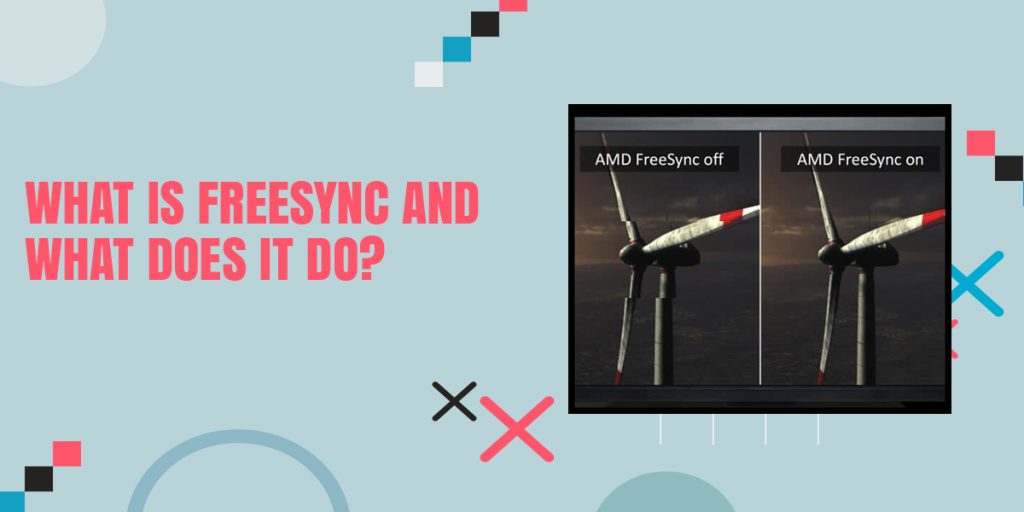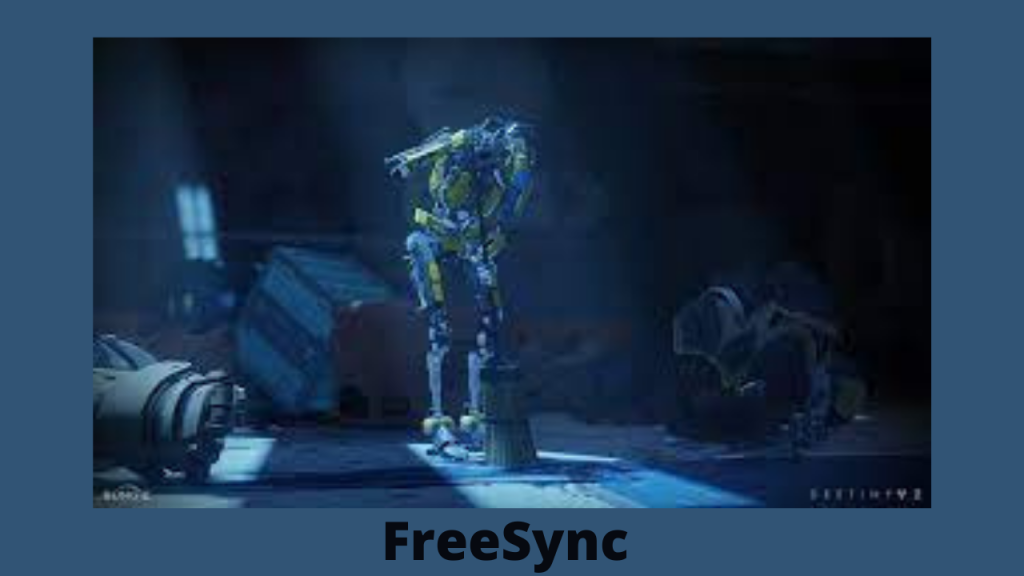
What Is FreeSync And What Does it Do? Have you had the same question but did not find the answer? Don’t worry. We got you covered.
FreeSync technology helps reduce screen tearing and stutter without impacting picture quality.
Normally, when you move the mouse or touch the screen, your computer automatically updates the screen to match your movement. But with G-SYNC, your computer and monitor work together to make sure the movement is tracked.
As a result, the picture stays smooth and there are no annoying screen glitches. In other words, with G-SYNC, your video gameplay will be as fluid and responsive as playing it on a supercharged, high-end PC or console.
What this means for you is an improved gaming experience that makes everything from simple scrolling to complex 3D interactions feel more responsive and lifelike. With G-SYNC, your gameplay will be more immersive, more fun, and more satisfying.
*Note: This technology is only available on select NVIDIA GeForce GTX 10 series graphics cards and selected 2017-2018 Alienware laptops with an Intel i7 processor. If you have one of these systems, check with your computer dealer to see if you qualify for the limited free trial offer.
Also, this technology requires an Ultra HD (3840 x 2160) display with support for G-SYNC HDR.
If it’s not, you’ll still get the benefits of lower screen tearing and less screen stutter with the addition of v-sync. So, what’s the catch? V-sync only reduces the frequency of tearing and stuttering; it doesn’t eliminate them altogether.
Contents
What is FreeSync?

FreeSync technology synchronizes the monitor’s refresh rate (Hz) with the graphics card’s frame rate (FPS) to eliminate screen tearing and stuttering. AMD Radeon FreeSync synchronizes a compatible monitor’s refresh rate (Hz) with a compatible graphics card’s frame rate (FPS).
As a result, screen tearing and stuttering are eliminated within the supported variable refresh rate range of the display. AMD Radeon FreeSync technology uses the Adaptive-Sync protocols of DisplayPort and HDMI connectors to provide a variable refresh rate (VRR), which allows refresh rates of a monitor to change dynamically and in synchronization with frame rates of a graphics card.
Obviously, this is done for fluid gameplay and eliminates screen tearing and stuttering without impacting picture quality. In other words, with FreeSync enabled, your video gameplay will be as fluid and responsive as playing it on a supercharged, high-end PC or console. *Note: This technology is only available on select graphics cards and monitors from AMD.
What Does AMD FreeSync Do?
In the Quest gaming machine, FreeSync allows for a smooth interactive gaming experience by automatically adjusting the refresh rate of the monitor to match the frame rate of the game being played.
This eliminates screen tearing and stuttering, regardless of the graphics settings selected by the player. In addition, FreeSync reduces screen flicker for more comfortable gaming. In other words, with FreeSync enabled, your gameplay will be more immersive, more fun, and more satisfying.
*Note: This technology is only available on select AMD graphics cards and compatible displays from Dell, Lenovo, HP, Asus, Acer, and Samsung. If you have one of these systems, check with your computer dealer to see if you qualify for the limited free trial offer.
Also, this technology requires a display with a maximum supported variable refresh rate range of 40 – 75Hz. You can find out if your display supports VRR by going to www.amd.com/free-sync and clicking on “Display Test App”.
LFC (Low Framerate Compensation)
This function attempts to solve the problem of motion blur caused by slow or irregular movements of the player’s hands or any other part of the body which holds the game controller.
When a player moves the controller too fast or too slow, the game detects the movement and compensates by altering the timing of when the picture is updated on the screen. This has the effect of smoothing out the motion and eliminating motion blur. What Is LFC (Low Framerate Compensation)?
On an LCD monitor, LFC works by detecting the difference between the actual frame rate being displayed on the screen and the nominal frame rate specified by the monitor’s manufacturer. If the actual frame rate is slower than the nominal rate, LFC will add extra frames to the display to make up for the delay in refreshing the screen.
In other words, LFC “fills in” the gaps between individual screen updates. On the other hand, if the actual frame rate is faster than the nominal rate, LFC will reduce the number of screen updates to eliminate screen tearing. In either case, LFC will compensate and smooth out any difference between the actual and nominal frame rates.
How Does LFC Work?
LFC works by adding or removing frames from the display at the discretion of the graphics card. However, the timing of these additions or removals is governed by the operating system.
AMD FreeSync vs NVIDIA G-SYNC
The difference between AMD FreeSync and NVIDIA G-SYNC is very simple: With FreeSync enabled, the refresh rate of your monitor can be automatically changed by the graphics card and match the frame rate of the video game.
With G-SYNC enabled, the frame rate of the video game must match the refresh rate of the monitor. This ensures that the entire screen is refreshed before the next frame appears. There are a few limitations to keep in mind when choosing which technology you would like to use: AMD FreeSync is Available on select AMD graphics cards and compatible displays from Dell, Lenovo, HP, Asus, Acer, and Samsung.
If you have one of these systems, check with your computer dealer to see if you qualify for the limited free trial offer. Also, this technology requires a display with a maximum supported variable refresh rate range of 40 – 75Hz. You can find out if your display supports VRR by going to www.amd.com/free-sync and clicking on “Display Test App”.
G-SYNC is Available only on NVIDIA graphics cards and compatible monitors from Asus, Acer, and Samsung. You will not be able to use this technology if you own an NVIDIA graphics card and any other brand of monitor.
NVIDIA G-SYNC requires NVIDIA graphics cards and monitors. You will not be able to use this technology if you own an NVIDIA graphics card and any other brand of monitor.
How do I set up my system for AMD FreeSync?
Indeed, FreeSync works best with systems that already support DisplayPort 2.2 or HDMI 3.0, so it’s wise to make sure your graphics card, motherboard, and monitor are all compatible with one another.
In order to set up your system for AMD FreeSync, perform the following steps:-
- Set up the display for AMD FreeSync: First of all, ensure that you have the latest firmware installed on your monitor. You can find out if you have the latest firmware by clicking on the “About” button on your display. If you do not see the “About” button, then you have the latest firmware. If not, go back and update the firmware.
- Once you have verified that you have the latest firmware installed, it is time to connect your display to your computer. The display should be plugged into your computer through its DisplayPort 4.2 or HDMI 5.0 port, depending on which version of DisplayPort or HDMI you own.
- Make sure the DisplayPort or HDMI cable is securely attached to both the monitor and the computer. When the display is connected to the computer, the display will automatically detect your system’s video card and monitor and will display the proper driver information.
- After this, you should check the display’s menu to ensure that it supports AMD FreeSync. AMD FreeSync is supported on many high-end graphics cards, including those from AMD. AMD FreeSync is also supported on some gaming laptops. If your system has a display that supports AMD FreeSync, then you will see an “AMD” label in the graphics card’s name.
FreeSync Premium & FreeSync Premium Pro

After setting up your display for AMD FreeSync, you can now proceed to set up the graphics card for AMD FreeSync. In order to ensure that you have an AMD FreeSync capable graphics card, please refer to the specifications section of this article.
Once you have an AMD FreeSync capable graphics card, you should proceed to download and install the latest version of the AMD Catalyst™ Control Center (CCC). For Windows 7 or 8 users, you should download the AMD CCC version. For Windows 10 users, you should download the AMD CCC version.
Once you have downloaded and installed the AMD CCC, it is time to check if you have the latest firmware for your display. First, connect the monitor to your computer and then click on the “About” button on the display’s menu.
If you see the “About” button, then your display has the latest firmware. If you do not see the “About” button, then your display has not yet been updated to include the latest firmware.
Conclusion
FreeSync is a technology developed by NVIDIA and it allows the monitor to dynamically change the refresh rate of the screen based on the movements of the objects on the screen.
This means that the monitor displays images at the highest possible refresh rate possible (which is 60Hz) but the computer only sends a frame to the monitor every few milliseconds (1/120 second).
This is what the term “variable refresh rate” means. When the user moves the mouse or the pen, the computer sends more frames to the monitor which allows the user to see the movement of the object much faster.
This is called a “dynamic” refresh rate because the refresh rate changes with the movements of the object on the screen. The user does not have to change anything except the position of the mouse or the pen to get a better framerate.
So this was all about our informative guide on “What is FreeSync and What does it do?”
If you have any queries, let us know in the comments below.
- Write Smarter, Not Harder: Grammarly’s Next-Level Writing Support - July 15, 2024
- Is LOFT Worth It? A Detailed Review of Its Features and Benefits - May 6, 2024
- Weebly: The Ultimate Platform for Creating Stunning Websites - April 9, 2024
- bet365: the ultimate casino destination for indian players
- win big and have fun with bet365: india\'s best casino site
- bet365: the only casino site you need for indian gaming fun
- join the fun at bet365: india\'s most popular casino site
- discover the best casino site in india: bet365
- play the best casino games and claim huge bonuses at bet365
- get ready to win big at bet365: india\'s premier casino site
- bet365: the online casino site that offers the best rewards
- why bet365 is the best casino site for indian players who love to win
- looking for the best casino site in india? look no further than bet365
- bet365: the casino site that offers the best gaming variety for indian players
- experience the thrill of casino gaming with bet365
- get your casino gaming fix at bet365, india\'s leading site
- join the fun and win big with bet365: india\'s top casino site
- discover the best casino site in india for big jackpots: bet365
- bet365: the casino site that offers the best experience for indian players
- play your favorite casino games at bet365, india\'s most trusted site
- why bet365 is the only casino site you need for indian gaming fun
- bet365: the premier casino site for indian players who love to win
- get in on the action at bet365, india\'s best online casino